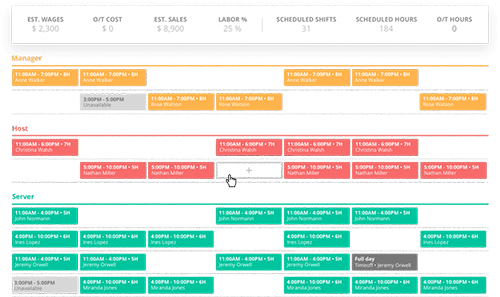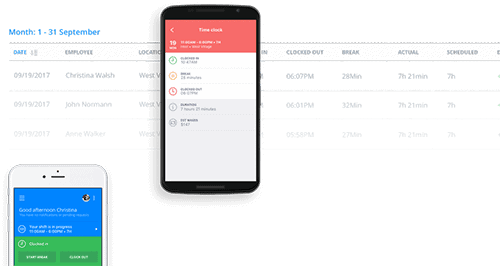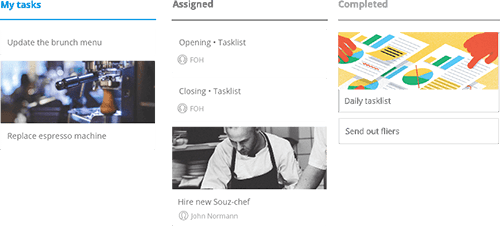11 Types of Job Shifts Managers Should Know
There are many different job shifts available to choose from. Learn about the mo...

Are you searching for a way to recognize your employees for their years of service, reward them for a job well done, and retain them longer? Sounds like a tall order, doesn’t it? Actually, it’s not as difficult as you may think. You can achieve all three of those goals — recognizing, rewarding, and retaining — by instituting employee incentive programs.
But what perks should you offer? Do they have to be grand, expensive gestures? In this article, the experts at Sling answer both those questions with a list of employee incentive programs that actually work.
Simply pick and choose the ones that are right for your business and don’t be afraid to exercise your creativity and try new things until you find what works for your team.

Employee incentive programs are rewards and privileges a business uses to motivate, inspire, and encourage employee performance and productivity.
One of the many nice things about employee incentive programs is that they can be as simple or as complicated — as inexpensive or as expensive — as you want them to be.
The built-in flexibility of the concept means that your business can customize the rewards to fit the interests of everyone on your team. That same flexibility also means you can tie the employee incentive programs to any purpose or goal you want to reach.
For example, if customer satisfaction has dropped over the past six months, you could create an incentive program that encourages employees to do better in this area.
Or, if task completion has fallen below the norm in recent weeks, you could implement an incentive that motivates team members to push the numbers back up.
It all depends on what you want to see happen in your business.
Whatever metric you tie them to and whatever rewards you offer, employee incentive programs are a great way to inspire your team to focus on improving some aspect of their performance.

The primary difference between employee incentive programs and benefits (regular or fringe) is that the former are optional perks while the latter are mandatory additions to your business’s payment package.
Common benefits include:
Another way to look at the difference is that benefits are not tied to performance; employee incentive programs are.
With benefits, employees will receive the sick leave, the healthcare, and the paid time off whether they perform well or not. But, with incentive programs, your team may “win” the reward, or they may not — it all depends on their performance.

This incentive is super simple and doesn’t cost you a penny. Set aside one day every week or month for your employees to bring their pets to work. This perk has been around since humans first domesticated animals and has remained popular for all those years for one simple reason: it works.
Employees with pets love to show off their furry companions, and those without pets of their own get to experience the joys of interacting with animals all day long. Pets in the office also stimulate a sense of well-being that can’t be achieved any other way. All of that translates to a more productive team.
Want an easy incentive program that fosters good behavior? Set up a perfect attendance bonus. Here’s how it could work:
That adds up to $2,000 per year if an employee can make it through 12 months without missing work.

Don’t penalize your employees for getting sick. Instead, give them the time they need to recover without worrying that their job is on the line. Most employees would much rather be at work than suffering at home with the flu.
Plus, you don’t want the sick team member to feel like they have to report to work, where they will surely spread their germs all over the office. That could result in many more absences than if you had just given the sick employee the time off they needed to recuperate.
This is another employee incentive program that doesn’t cost much but can make your team members feel appreciated. Offer a reward for each year your employees have worked for your company.
Maybe the reward is a blue shirt at the end of every year. The more years each employee has worked at your company, the darker their shirt. Then set aside a day for everyone to wear their blue shirts.
This promotes a sense of comradery, provides the long-time employees with a pat on the back, and gives new employees something to shoot for.
One company offers the following benefits to the spouse of a deceased employee:
That employee incentive program may be unrealistic for small- and mid-size businesses, but perhaps the idea of it will inspire you to create a similar perk that works for you.
This won’t work for call centers, restaurants, and retail, but office-based businesses may find it useful to take the week off between Christmas and New Years. This gives employees time to relax and visit family, prevents them from mentally checking out between the two holidays, and helps them work harder in the new year.
Additionally, chances are that many of the companies you do business with will also be closed during this week. That means less work gets done, productivity suffers, and your team members will wonder why they came in. Take the week off to avoid all the problems and stress that the holidays can bring.
Here’s an idea: offer incentives if your team members commute to work in an eco-friendly manner. They could walk, bike, rollerblade, carpool, take the train, or ride the bus. If they do, they are reimbursed the cost of that transportation (up to a set amount per day) in their paycheck.
This perk probably won’t work for rural businesses or those with few public transportation options. But for companies in larger cities, it’s a smart way to give back to the community, the environment, and your employees.
When your employees are relaxed, they are better able to focus on the job at hand. And what’s more relaxing than a massage? If you want better focus and better work, bring in a masseuse once a week to give free 10- or 15-minute massages to all team members.
Some companies subscribe to the adage that innovation requires inspiration. To keep the creative juices flowing, include an inspiration account in your employee incentive program.
Provide each team member with a set amount of money that can be used to further their personal growth. Don’t put limits on the money (even though you may want to), and let your employees run wild with it.
Yoga lessons? Skydiving? Guitar lessons? The sky’s the limit because you never know where inspiration will strike.

Monday is laundry day at one Venice, California-based media company. After a long weekend of fun in the sun, all 80 employees can turn in their clothes to be washed, dried, pressed, and returned to them by the end of the day.
That simple service allows them to relax when they go home so they won’t already be exhausted when the next workday rolls around.

When you offer the option of flexible scheduling to your employees, you give them a bit of freedom within a very structured system. Ditching the 9-5, or at least being flexible about when hours are worked, helps your team members feel in control of their own schedule.
We’re not advocating cutting employee hours down to part-time. Rather, we’re suggesting that you try new ways to accumulate 40 hours every week. Here are a few examples of flexible schedules that might work in your business:
Flexible work hours are a wonderful incentive for your employees, but they are also a nightmare to schedule. That doesn’t mean you have to chuck the idea completely. Instead, incorporate a cloud-based employee management app, like Sling, to give you and your employees the ability and freedom to create the schedule that works for your business.
Employees can access Sling anytime from their phones, mobile devices, or desktop computers. They can request time off, find their own substitutes, tweak their schedules to fit their needs, and so much more.
It also gives you, the manager, the ability to track the hours your employees have worked without your physically being there. This power and flexibility even extend into the next entry on our employee-incentive-program list.
With the proliferation of the internet and the interconnectivity of all things, telecommuting has never been easier. In fact, team members no longer have to report to an office every day — or even live in the same state, country, or continent.
Managers can direct the activities of their team members with apps and software, like Sling, that were unheard of just a few short years ago.

Sling allows employees to clock in and out from any device with an internet connection. It even allows managers and supervisors to see who’s clocked in and who’s not. This feature works whether your team assembles in your restaurant every morning or is spread all over the globe.

But the connectivity doesn’t stop there. Sling offers features like Tasks and Messages that let you manage your employees from anywhere, communicate freely and easily, and stay engaged at all times even if everyone works from different locations.
That makes telecommuting a feasible perk that you can offer to all your team members.
Make it easy for your employees to improve their skills by reimbursing part or all of their tuition when they take a class that is relevant to their job.
Want to improve productivity and morale? Share the profits. Set aside a percentage of the net profits for four months, six months, or 12 months and divide it equally among your employees. This is a great way to motivate your team members to keep pushing those profit numbers up.
Boost your employees’ health and their work performance at the same time by offering wellness benefits. It might be something as simple as $500 a year for a gym membership, but the results can have a profound effect on the happiness and productivity of your employees.

If your team meets certain goals for all four quarters, arrange an end-of-the-year team retreat. Plan something that will appeal to everyone (as much as possible), like a weekend in the city complete with tours, team activities, and maybe a show in the evening.
If you want your employees to work hard to keep your company growing, consider giving them the business. We’re not talking the whole kit-and-caboodle all at once. A third of it over ten years would work well.
Then the holding company could begin to purchase the rest of the business over the next 20 years until they own it all. It’s a unique employee incentive program that can pay dividends in productivity over the long haul.
We’ve already talked about instituting a flexible schedule, but maybe you don’t want to go that far. Flex time allows your employees to arrive at work anytime between certain hours (e.g., 7 a.m. and 10 a.m.) as long as they work a full eight hours.

Maybe you don’t want your employees wearing sweatpants and t-shirts with holes in them to work, but you could relax the dress code just a little as an employee incentive program. If your team meets its goals, start with casual Friday and then maybe increase it to casual Monday from there.
Giving time off to volunteer is a great way to benefit your employees and your community. You can organize this employee incentive program as a team activity, or allow individuals to take a day off to volunteer when it’s convenient for them.
After a job well done, a work happy hour may be just the reward your employees are looking for. There are so many options for this employee incentive program that you’re really only limited by your imagination.
Here are a few ideas to get you started:
Conducting an office Olympics is a great way to blow off steam and build group cohesion. You can compete as individuals or divide into teams for a livelier event. Here are some ideas for events:
This one is simple: reward your employees by purchasing a corporate museum membership and allowing them to take their families whenever they want throughout the year.
Your employees lead busy lives. Finding time to clean their house or apartment can be a difficult task. Set up an employee incentive program that pays for a cleaning service to tidy their dwellings once a week or twice a month.

Everybody loves a good concert. If there’s an event coming to your area that you think your team would enjoy, get tickets and attend as a group.
Rewarding high-performing employees with branded gear is a fun and easy way to motivate your team to reach its goals — and get a bit of free advertising in the process.
Using branded gear is an incredibly flexible incentive. You can put your company name, logo, and color scheme on all manner of fun and useful objects, including:
There are so many different options for branded gear that you’re really only limited by your imagination.
Research custom printing, find the items that appeal to your employees the most, and then use those as a way to inspire your team to greatness.
If your local lottery has a big jackpot coming up — or, even if it doesn’t — you might consider offering lottery tickets as an incentive for reaching certain goals.
Sometimes, the drawings with the really high numbers come up without a lot of warning so you might have to set up the program and wait for the next eight-, nine-, or ten-figure jackpot to roll around.
But, really, there’s no reason the regular lottery won’t work as well. Even the opportunity to win a few hundred, or a few thousand, dollars is enough of a reward to propel your employees to new levels of success.
It’s also useful to remember that lottery tickets can be an individual reward or for the team to split. Either way, it’s a fun and inexpensive way to motivate your employees to improve some aspect of their job.

This incentive is super simple and inexpensive to execute. Here’s how it works:
The next month, award the spot to a different high-performing employee. You can even customize the sign on the spot with the employee’s name to make it more special.
This incentive doesn’t work for a team, but it is a fun way to encourage each individual to reach their goals.
If you have unoccupied space in your office, consider using it as a reward for achieving some goal. Outfit it with a nice desk, a comfy chair, a mini-fridge, and its own dedicated equipment (e.g., copy machine, fax machine, coffee machine, etc.).
Then, grant personal use of this space for a week or a month to the employee with the highest numbers (or whatever metric you use to measure success).
If your team’s workspace is due for a bit of updating, consider using it as an opportunity to energize your employees to improve.
Set a goal and then offer to upgrade the workspace when they fulfill the objective.

It’s a fact: Coffee makes the world go ‘round. Nowhere is this more true than at work.
Use this fact to your benefit by offering to install a fancy coffee machine for everyone to use if the team reaches the goals you set.
Pizza, like coffee, is one of those incentives that always seems to motivate employees to work harder. Consider setting up a team incentive program with the award being pizza for lunch every Friday for a month (or every other Friday for two months).
However you structure it, pizza is a prize that everyone will work hard for.
Design a program with multiple levels and offer to upgrade the breakroom in different ways when your team reaches each level.
For example, you might:
This multi-tiered reward system is also a great way to combine several of the programs on this list into one large incentive.
For more ideas on how to make the best use of your break room, check out this article from the Sling blog: 18 Break Room Ideas For Your Workplace.
Implement this incentive program in your standard operating procedures as a way to show your team members that their opinions matter.
When an employee makes a suggestion and it leads to some type of improvement in your business (e.g., higher revenue, increased productivity, enhanced efficiency, etc.), reward them with one of the options on this list (or some other option) to show your appreciation.
Another useful employee incentive program you can operate year in and year out is the referral bonus.
Outline the program in your employee handbook and provide some type of prize (monetary or otherwise) for any team member who provides the name of someone who eventually gets hired into your company.
Team members often ask this question, but managers and owners know the truth: Payroll is taxed twice, but perks and incentives can be written off as a necessary business expense. That means employers can get more bang for their buck and pass the savings on to their employees.
That’s a win-win for everyone involved.

The one constant running through most of these employee incentive programs is time: time to volunteer, time to clean, time for vacation. And the only way to get control of the time you and your employees spend working is with a scheduling software like Sling.
Sling helps you maximize the potential of each shift so you can create the best team for the job. Sling provides suggestions and notifications when you accidentally double-book someone or you forget to take into account a time-off request. And that’s only the tip of the iceberg.
Sling can even help you track and control labor costs, communicate with all your employees, assign tasks, and keep everyone on track. It really is the complete solution for scheduling, organizing, and managing all your employees.
For more insight into how you can simplify and streamline your scheduling and employee-management processes — and to get started with a free Sling account — visit GetSling.com today.
See Here For Last Updated Dates: Link
This content is for informational purposes and is not intended as legal, tax, HR, or any other professional advice. Please contact an attorney or other professional for specific advice.
Schedule faster, communicate better, get things done.